Hansgrohe | How collaboration will drive sustainable choices for bathrooms
Head of innovation & sustainability at Hansgrohe Group, Steffen Erath on collaboration and why retailers must help consumers make sustainable choices
Ahead of ISH 2025, head of innovation & sustainability at Hansgrohe Group, Steffen Erath talks about manufacturer collaboration and why retailers must help consumers make sustainable choices

It could be said sustainability is embedded throughout the Hansgrohe Group, from its water-efficient brassware fittings, through to the use of the colour green in its premium brand’s logo, and a move to plastic-free packaging by the end of 2025.
Such has been its environmental focus, the company recently achieved a Platinum Medal in the EcoVadis sustainability rating.
Sponsored Video
It reportedly places Hansgrohe in the top 1% of 130,000 assessed companies.
And its sustainability journey is continuing at pace.
Alongside showers, taps and new product categories, as part of its strategy to offer a complete bathroom, the company will reveal a new collaboration at ISH 2025.
On a 2,000sqm stand, the manufacturer will introduce an exhibition area themed “Sustainable Living”.
Head of innovation & sustainability at Hansgrohe Group, Steffen Erath, explains: “We’re diving more into water and green technology.
“When you go in this direction, you have to create partnerships with other companies.
“I think, in the next 10-20 years, the companies who will outperform their peers are those who collaborate and think in ecosystems to really move the needle and accelerate the transformation.
“Because if only we transform, it doesn’t solve the problem.”
Bathroom leader collaboration
It is this need for collaboration which saw the Hansgrohe Group attend the UN 2023 Water Conference in New York, only the second event in 46 years.
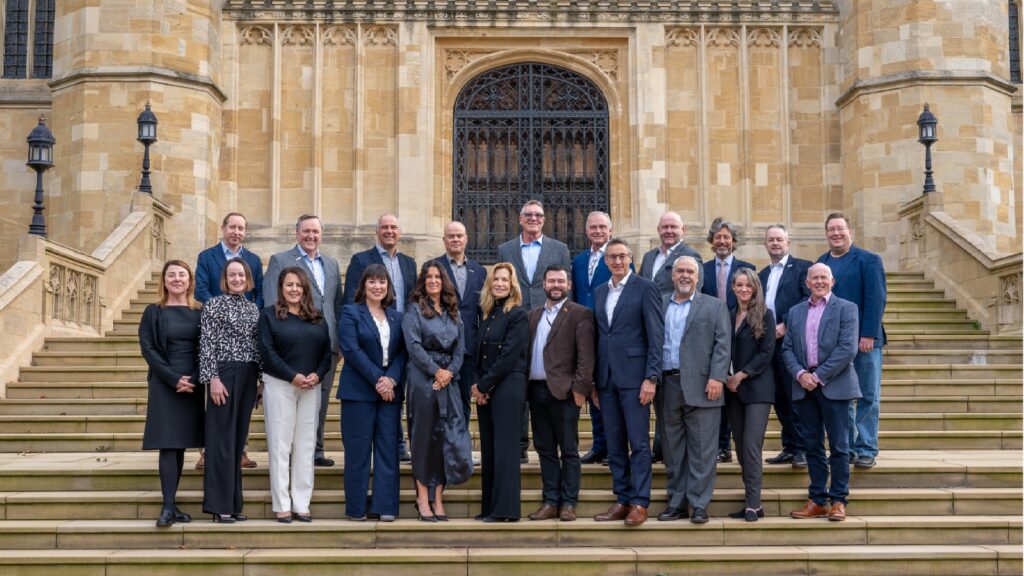
World bathroom leaders sign global declaration to reduce water waste
Most recently, CEO of Hansgrohe Group, Hans Juergen Kalmbach joined the executive board of Water Europe, a body promoting water technology with s vision to create a “water-smart” society.
Hans Juergen Kalmbach was also among the global bathroom leaders who signed a landmark agreement to design new products reducing water waste and potential risk of deadly bacteria spreading through the use of bathrooms.
“We try to inspire others and bundle our voices together, because water is not the only crisis”, Steffen Erath warns.
“We have the climate crisis. We have biodiversity loss. We have a resource crisis with materials. That’s the difficulty of our times.”
So, to manage the far-reaching topic of sustainability, which covers all these areas, Erath points to the company’s focus on its biggest levers of water, carbon and circular economy – in that order.
Water spray competence
It’s certainly a long way from the company’s first steps on its sustainability journey, when Klaus Grohe, son of Hans Grohe, joined the firm and brought with him values of using water responsibly.
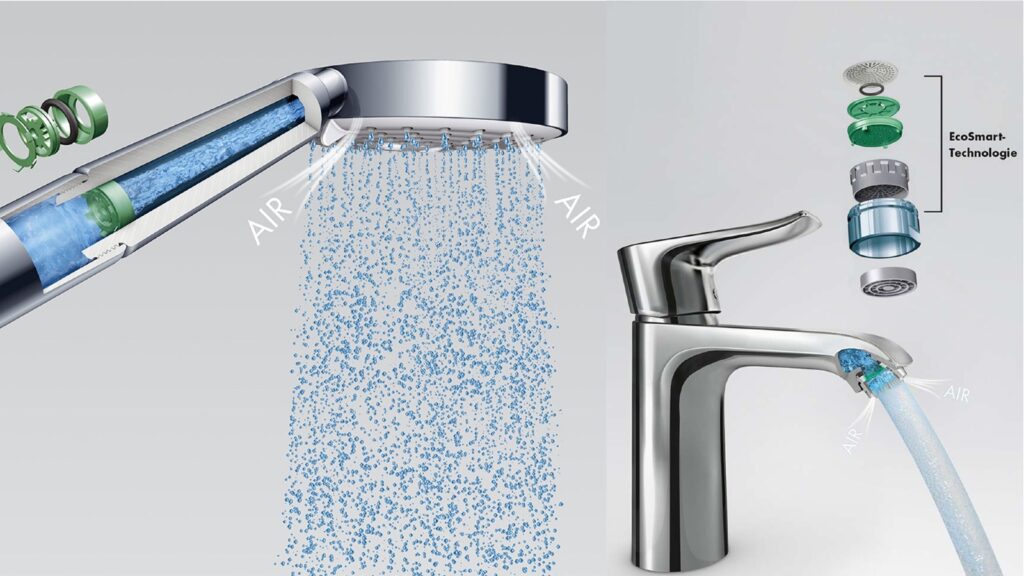
Ecosmart water saving technology in Hansgrohe showers and tap
It began with the production of the Mistral Eco handheld shower in 1987, which introduced a water-saving function.
“It wasn’t that successful in the market, because a lot of people didn’t know about water scarcity.
“But undeterred, he decided to introduce water-saving technology for showers.
“Here, in the usage phase of the products, we see the biggest lever for making our portfolio more sustainable”, says Steffen Erath.
In fact, water spray technology is now a core competence of the group, having developed its own spray lab.
“Like people from Scotland have many words for rain – I learned – we at Hansgrohe have many words for spray”, Steffen Erath comments.
With the belief it is a manufacturer’s responsibility to create water-efficient products, all Hansgrohe’s products are water-efficient, with a goal for them to all be water-saving by 2030.
Green vision reality
But how much water can Hansgrohe products save?
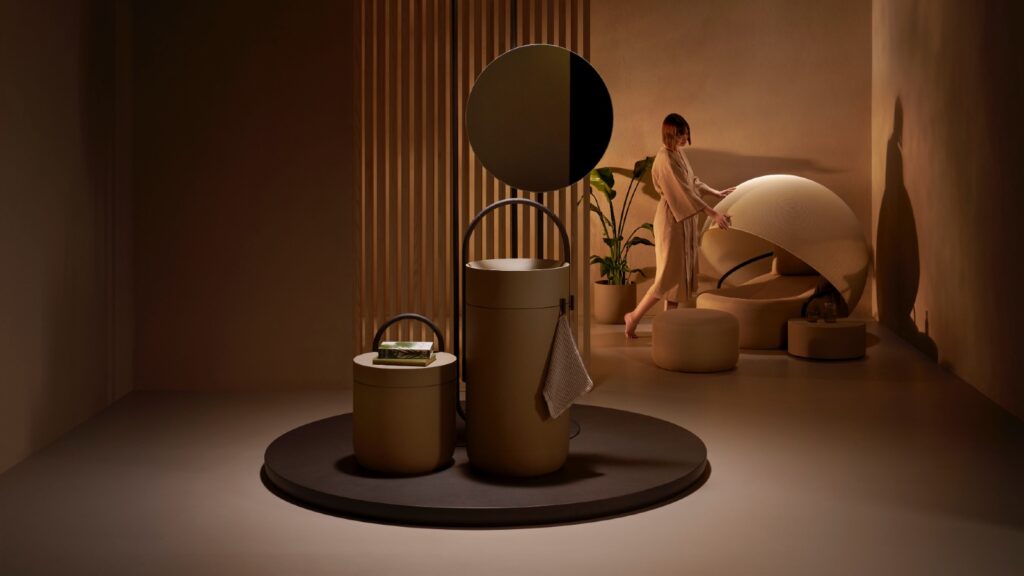
Green Vision Beyond Water: Rethinking Bathroom Culture introduced at ISH 2023
Determining the boundaries for water-saving, the Hansgrohe Group introduced Green Vision Beyond Water: Rethinking Bathroom Culture at ISH 2023.
It showcased a bathroom that used 90% less water, energy and carbon and was created in “warmer” colours, to provide a psychological effect, leading to lower hot water consumption.
“If you find the boundaries, you feel more comfortable to reduce water use”, explains Steffen Erath.
He adds: “It’s not that we will start taking a shower with two litres of water per minute in the future, but if it works with two litres, it shows you the direction it can go.
“With new technology, the Green Vision will become reality I’m sure, although perhaps not exactly how we showcased it at ISH 2023.”
The Green Vision included the use of grey water where shower water could flush the WC, together with a heat recovery system.
“Grey water makes a lot of sense. We had an idea to have a recycling shower 15 years ago, but legislation doesn’t allow the use of recycling water in Europe.”
However, elements of Hansgrohe’s Green Vision have now come onto the market.
Having developed a recycling process to strip galvanised products and reuse ABS plastics, Hansgrohe has introduced the Pulsify Planet handheld shower.
“The material we featured on the Green Vision included recycled ABS plastic.
“We have used 80 tonnes of recycled ABS to produce Pulsify handheld showers, so you already have part of the Green Vision in your hands.
“We showed it to the complete industry because we said feel free to follow. It’s not about a USP. It’s not about competitive advantage, it’s about collaborative advantages”, says Steffen Erath.
And he adds the company will be expanding the use of its recycled plastics, explaining: “The Green Vision is our North Star.”
Consumer behaviour
Hansgrohe can innovate in water-saving spray technology, and recycled materials, yet it is still the behaviour of the consumer which can determine water use in the bathroom.
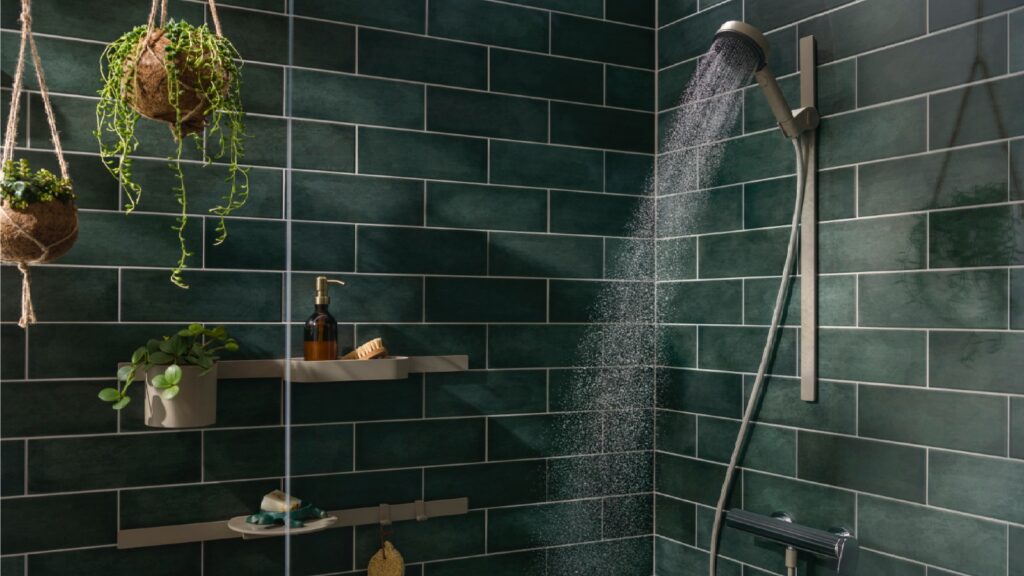
Pulsify shower and bathroom accessories
“To be honest, I think only 20% of consumers are ecologically aware”, says Steffen Erath.
He adds: “I think for many it’s difficult to understand ‘what can I do if there are 18 million consumers on the planet. What can I change?’”
He says considering human behaviour is part and parcel of product design.
“When we’re designing, we are trying to solve problems – water and energy use are big problems. But, when you sell the product, you also have to promote the benefits.”
Steffen Erath continues: “So if we have a water saving handheld shower, only around 20% of people will buy the handheld shower because its water saving.
“But to reach a broader mass of consumers, you have to point out water saving is energy saving.
“Taking a warm shower consumes the same amount of energy as driving a Tesla on the German autobahn for one minute.
“If you can say ‘using a water-saving shower can save a family maybe £300, every year’, even undecided consumers may buy the product.”
He urges retailers to help consumers with making sustainable choices, otherwise government will take the lead.
“If consumers don’t react, if businesses don’t react, then government comes in and will restrict choice.
“We would rather lead this transformation, and we do it with innovation.
“You could save water by reducing the flow or time taken showering, but I think the innovation is there shouldn’t be a compromise”, Steffen Erath states.
Circular economy challenge
However, Erath actually believes the biggest challenge for sustainability in the bathroom industry is creating a circular economy.
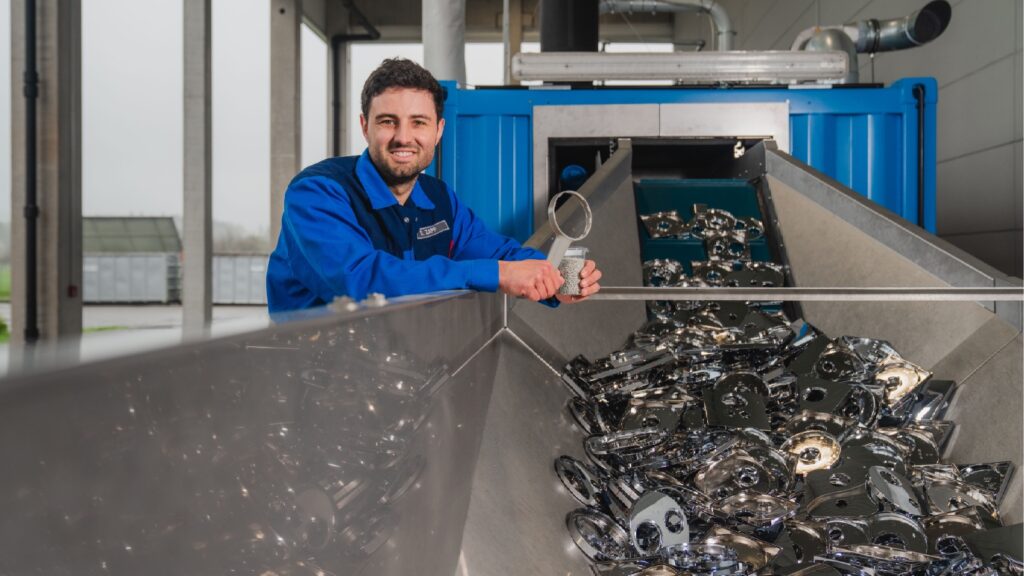
The Hansgrohe Group has introduced a recycling process allowing decoated ABS plastic to be used to produce new parts
Erath says the industry still has to answer the questions: “How do we take products back and reuse and recycle, closing the loop so we’re not always importing brass and zinc?
“How can we use what we have already built and use it as a resource?”
Hansgrohe has already made a step in this direction, by recycling ABS plastics.
Erath says the next step would be to reuse showers and taps after end of life.
“This would be a dream for the complete building industry”.
Steffen Erath concludes: “We have to become a circular economy, but this is a tough challenge”.
Related Articles
#socialwall
Sintered stone manufacturer Neolith has launched Calacatta Roma and Cappadocia Sunset, inspired by nature and classical architecture, and for use in kitchens or bathrooms walls, floors, in gardens or facades.
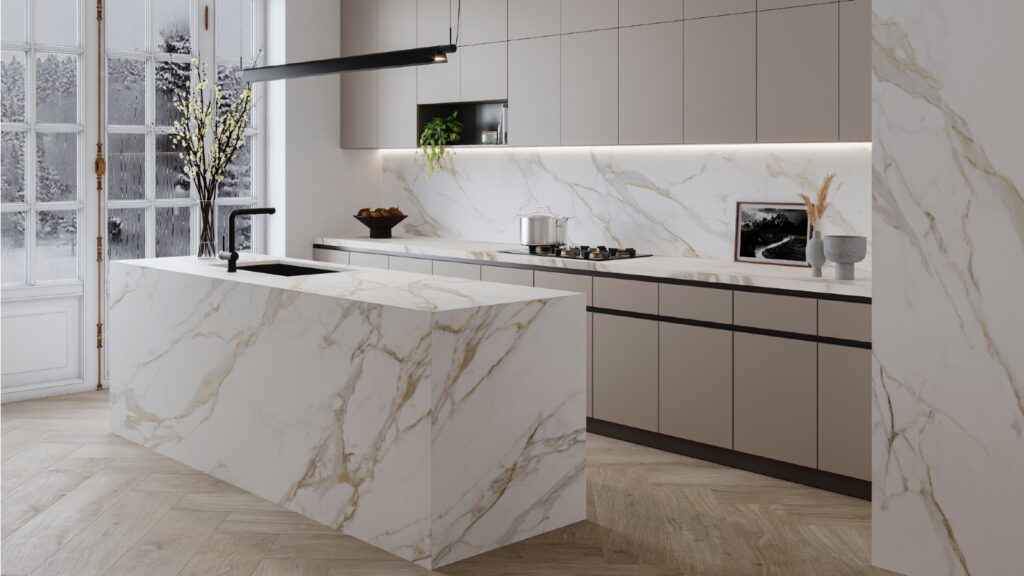
They belong to The New Classtone and Fusioncollections which interpret marble and natural stone, respectively, and boast Neolith’s antibacterial NeolEAT technology.
Inspired by Ancient Rome, Calacatta Roma (pictured top) pays homage to Italian Carrara marble, with ochre and grey veins in a white background.
While the Cappadocia region, in central Turkey, with its rock formations formed by volcanoes and underground cities, has inspired Cappadocia Sunset (pictured below).
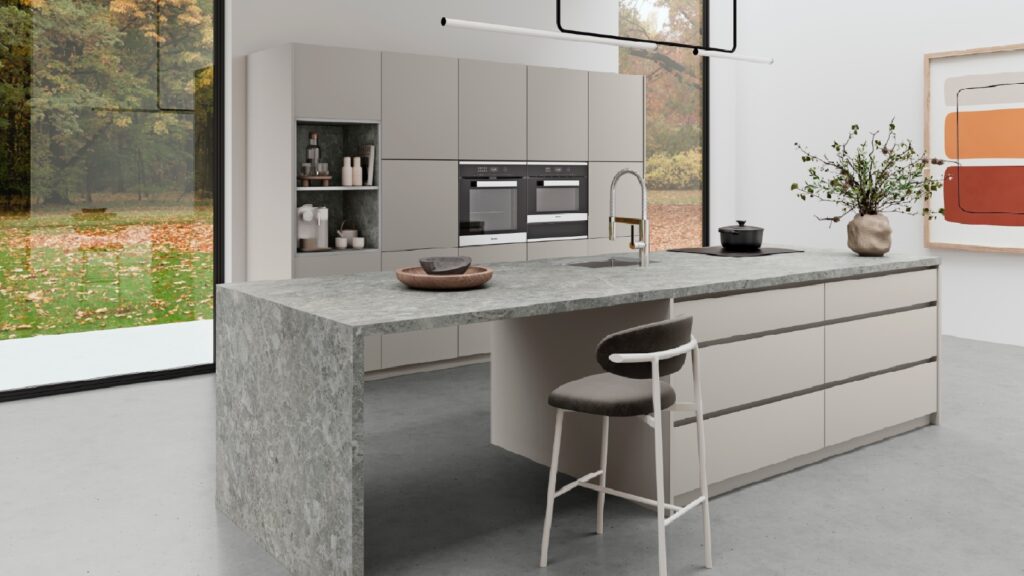
Just like all of Neolith’s surfaces, Calacatta Roma and Cappadocia Sunset are resistant to heat and atmospheric conditions, are 100% recyclable, and do not contain added quartz to their formulation.
Mar 14, 2024
JUST OUT: @AcquabellaBath has unveiled a choice of shower grate patterns for its Base and Arq shower trays… https://t.co/kMN83c40Qf
JUST OUT: @FrankeUK unveils Mythos single lever mixers in Swivel Spout and Pull-out Nozzle options. #kitchendesign https://t.co/TSKCAo5r0e
INTERVIEW: Sales and marketing director of @blumuk David Sanders on how the kitchen industry has changed post-pand… https://t.co/k9LIpUhhDF
NEWS: Challenging housing market is driving home improvements, finds new research by @HafeleUK #HomeImprovement… https://t.co/eMB7jludIm
NEWS: British manufacturer @kudosshowersltd acquired by European SanSwiss. #acquisition #manufacturers #bathrooms https://t.co/gpOv7jMevn
NEWS: @HafeleUK announces Richard Curtis as managing director. #newhire #appointment #leadership https://t.co/NP8U5ramOb
NEWS: @officialbikbbi names CT1 sealant manufacturer as corporate sponsor. #installation #installer https://t.co/8zsxs2HI3n
NEWS: @quookeruk named one of fastest-growing companies in North West. #business #Awards https://t.co/9zZ1ZDGrFI
RETAILER FOCUS: Managing director and design director of UK Kitchen Retailer of the Year @KitchensbyJSG Jim Geddes… https://t.co/JhL3vmxwbd
NEWS: Consumers are renovating for long term, with kitchens and bathrooms a priority, finds @HouzzUK… https://t.co/9VhoTUDI0B
PROFILE: Managing Director of Flair Showers Alan Wright talks about the relaunch of the company, creation of a Show… https://t.co/WDMPqDt2Uk
The new @blumuk carbon black LEGRABOX boasts beautifully slim drawer sides, bringing furniture onto trend, easily b… https://t.co/DrEXXWTyQb
NEWS: House of Fraser owner @FrasersGroupPLC enters strategic partnership with @ao, buying a stake in the online e… https://t.co/44N0O9bekn
NEWS: @HowdensJoinery awarded @WhichUK Best Buy for its rigid cabinets and handleless kitchens. #kitchen… https://t.co/rALz8XRHbv
NEWS: @grohe invites 800 guests from around the world to its Grohe X Professional event in Lisbon, Portugal.… https://t.co/2RGjDum980
JUST OUT: Home appliance brand Candy has unveiled the Rapido dishwasher, claimed to be the fastest and most spaciou… https://t.co/mbWn2pJp2C
Newsletter
Sign up to receive our newsletter and we’ll send you details of our latest videos, competitions and much more

